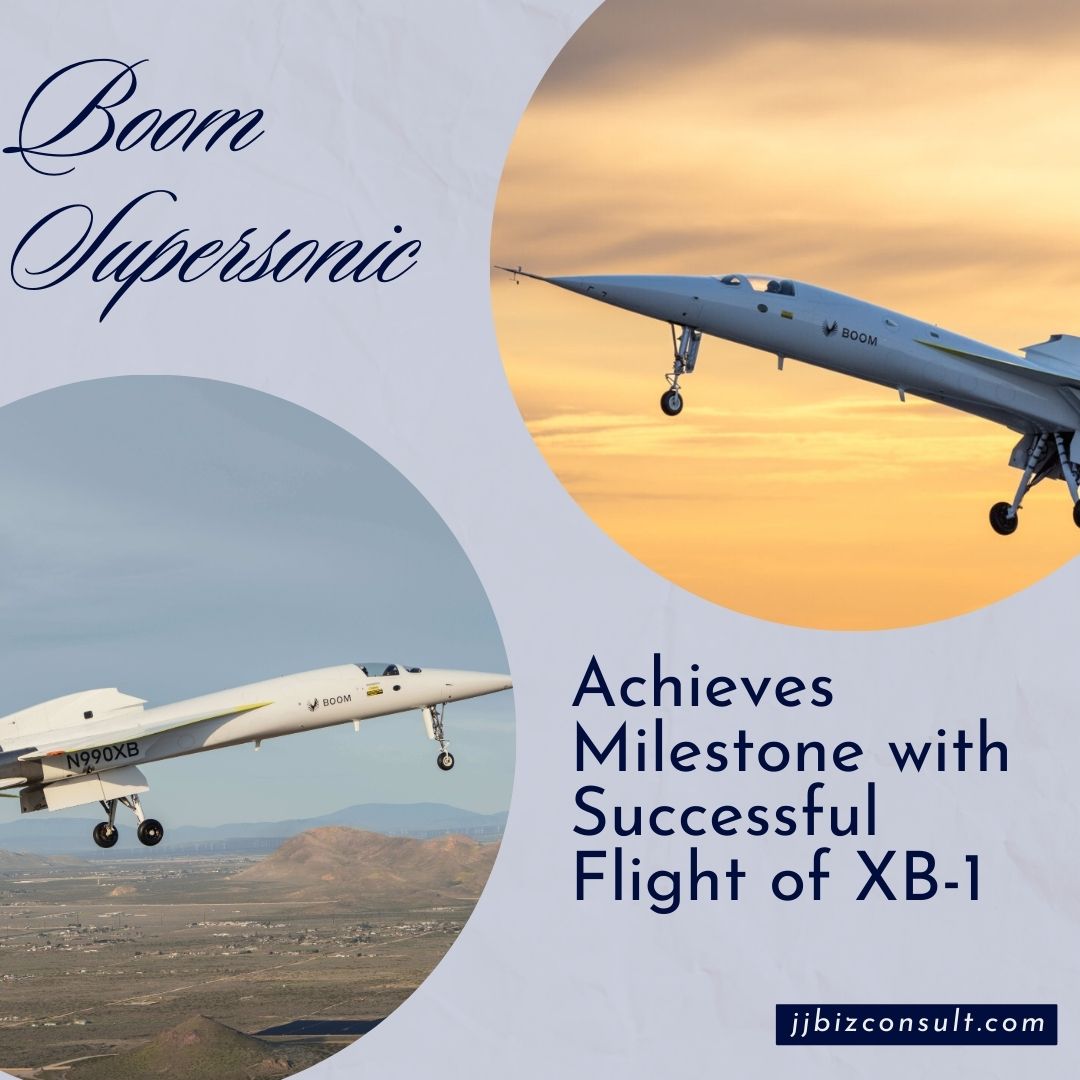Boom Supersonic Achieves Milestone with Successful Flight of XB-1

In a significant leap forward for the return of supersonic travel, Boom Supersonic proudly announces the successful flight of its XB-1 demonstrator aircraft. This groundbreaking event took place at the Mojave Air & Space Port in Mojave, California, marking a historic moment in aviation history.

Introduction: Boom Supersonic XB-1
In a historic moment reminiscent of the Concorde era, Boom Supersonic has achieved a significant milestone with the successful flight of its experimental aircraft, the XB-1. This supersonic jet, designed to bring back high-speed passenger travel, soared above the Mojave Air & Space Port in California. As the aviation industry seeks more sustainable alternatives, Boom Supersonic aims to create an environmentally friendly successor to the iconic Concorde.
XB-1: The Carbon Fiber Marvel
1. The Maiden Flight
On a clear day in California, the XB-1 took off, breaking through the sound barrier in the same airspace where the legendary Bell X-1 first achieved supersonic speeds in 1947. The XB-1, affectionately known as the “baby boom,” is a carbon fiber marvel that leverages cutting-edge technologies for efficient supersonic flight. These technologies include:
- Carbon Fiber Composites: The XB-1’s lightweight structure is crafted from advanced carbon fiber composites, ensuring strength and aerodynamic efficiency.
- Advanced Avionics: State-of-the-art avionics systems enhance safety and precision during flight.
- Digitally-Optimized Aerodynamics: The XB-1’s sleek design minimizes drag and maximizes performance.
- Supersonic Propulsion: Powered by three GE J85-15 engines, the XB-1 generates a combined maximum thrust of 12,300 pounds.
2. Paving the Way for Overture
The XB-1’s successful flight marks the return of civil supersonic travel after the Concorde’s retirement. However, Boom Supersonic has grander ambitions. Their flagship airliner, Overture, is poised to revolutionize air travel. Here’s what makes Overture special:
- Speed: Overture will fly at twice the speed of today’s airliners, drastically reducing travel time.
- Sustainability: Boom Supersonic is committed to sustainability. Overture is designed to run on 100% sustainable aviation fuel (SAF), minimizing its environmental impact.
- Carbon Neutrality: The XB-1 test program is fully carbon neutral, thanks to the use of sustainable aviation fuels and carbon offsetting.
Conclusion: Boom Supersonic XB-1
As Boom Supersonic advances toward Overture’s debut, the skies are abuzz with anticipation. The environmentally conscious offspring of the Concorde promises a greener, faster, and more exhilarating future for air travel. So, keep your eyes on the horizon—Boom Supersonic is rewriting the rules of flight, one supersonic leap at a time.
Watch the skies. Watch Boom Supersonic. 🚀🌎

Founder and the Chief Pilot of Boom Supersonic on the Initial Flight
Blake Scholl, the founder and CEO of Boom Supersonic, expressed his excitement, stating, “Today, XB-1 took flight in the same hallowed airspace where the Bell X-1 first broke the sound barrier in 1947. This marks the most significant milestone yet on our path to bring supersonic travel to passengers worldwide.”
Piloted by Chief Test Pilot Bill “Doc” Shoemaker, the XB-1 soared through the skies, tracing the footsteps of iconic aircraft like the Bell X-1, the North American X-15, and the Lockheed SR-71 Blackbird. The successful completion of the flight, meeting all test objectives including reaching an altitude of 7,120 feet and speeds up to 238 knots, underscores the exceptional capabilities of the XB-1.
The XB-1 program
The XB-1 program not only lays the groundwork for Overture’s design and development but also prioritizes a safety-first culture in engineering and manufacturing. Ric Parker, Chair of Singapore Aerospace Programme and former Rolls-Royce CTO, hailed this achievement, remarking, “Boom Supersonic is the first civil business entity to create its own X-plane, a supersonic demonstrator. This milestone is on the critical path to deliver Overture, the first supersonic transport aircraft to enter service in over half a century.”
With XB-1’s successful flight, Boom Supersonic is poised to expand its flight envelope, confirming performance and handling qualities through and beyond Mach 1. As Overture advances towards production, with orders and pre-orders from major airlines including American Airlines, United Airlines, and Japan Airlines, the future of sustainable supersonic travel becomes increasingly tangible.

Akasaka Yuji, Representative Director, CEO Japan Airlines, expressed anticipation, stating, “Congratulations to Boom on the XB-1’s first flight. I am looking forward to seeing your realization of sustainable supersonic flight to and from Japan.”
Overture, designed to carry 64-80 passengers at Mach 1.7, represents a paradigm shift in air travel, offering unmatched speed, safety, and sustainability. Boom Supersonic’s achievements signify the power of innovation and determination, paving the way for a new era in aviation.
Source: BoomSupersonic
Challenges for Boom Supersonic
Boom Supersonic, despite its groundbreaking achievements, faces several critical challenges as it endeavors to revolutionize air travel. Let’s delve into these obstacles:
- Sonic Boom Reduction and Mitigation:
- When an aircraft surpasses the speed of sound, it generates a loud sonic boom due to sudden pressure changes in the air. This poses a significant challenge, as it can disturb people and structures on the ground.
- To make supersonic flight viable over land, Boom Supersonic must design aircraft with reduced sonic boom levels. Achieving this balance between speed and noise is crucial.
- Visibility During Landing:
- Supersonic aircraft face a unique challenge related to pilot visibility during landing. The longer the fuselage and more swept the wing, the higher the angle of attack, obstructing the view out the forward window.
- Boom’s XB-1 features a delta wing design that balances low-speed performance during takeoff and landing with high-speed efficiency during cruise. Unlike the Concorde’s hydraulically lowered nose cone, Boom employs a Forward Looking Vision System.
- This system includes redundant cameras, a multifunctional display, data acquisition, and inertial navigation. It provides pilots with crucial information about the descent ahead, enhancing safety and precision.
- Sustainability and Environmental Impact:
- As the aviation industry seeks greener alternatives, Boom Supersonic aims to create a sustainable successor to the Concorde.
- Their flagship airliner, Overture, is optimized to run on 100% sustainable aviation fuel (SAF). Ensuring a balance between speed and environmental impact remains a challenge.
- Economic and Commercial Viability:
- Developing supersonic aircraft involves substantial costs, from research and development to certification and production.
- Boom Supersonic must demonstrate that their technology is not only groundbreaking but also economically feasible for widespread adoption.
In summary, Boom Supersonic faces the dual challenge of pushing technological boundaries while ensuring practicality, safety, and environmental responsibility. As they continue their journey, overcoming these hurdles will pave the way for a new era of supersonic travel.

Timeline for Overture’s Commercial Launch?
Boom Supersonic has made significant strides in advancing its sustainable supersonic aircraft, Overture. Let’s dive into the timeline and key developments:
- Structural Supplier Agreements:
- Boom Supersonic has signed structural supplier agreements with key aerospace leaders:
- Aernnova: Responsible for designing and developing Overture’s wings. The gull-wing design enhances supersonic performance while improving subsonic and transonic handling.
- Leonardo: Handling the fuselage and wing box.
- Aciturri: In charge of the empennage (tail section).
- These partnerships ensure critical components are in place for Overture’s production.
- Boom Supersonic has signed structural supplier agreements with key aerospace leaders:
- Systems Configuration Revealed:
- Boom unveiled Overture’s full systems configuration, showcasing key components:
- Avionics: Advanced systems for optimal performance and safety.
- Flight Controls: Triple redundant hydraulic systems for reliable power.
- Fuel Systems: Enable sustainable aviation fuel (SAF) compatibility.
- Landing Gear: Designed for over 600 routes worldwide.
- All-Composite Aerostructures: Support Overture’s aerodynamic efficiency.
- Certified technologies reduce program risk and mature Overture through aircraft systems development.
- Boom unveiled Overture’s full systems configuration, showcasing key components:
- Commercial Order Book:
- Boom Supersonic has received orders and pre-orders for a total of 130 Overture aircraft from major airlines like United, American, and Japan Airlines.
- These commitments demonstrate strong industry interest in supersonic travel.
- Overture Superfactory:
- Commercial Launch Target:
- While specific dates may evolve, Boom aims to fly Overture commercially by 2030.
- Overture will be the first supersonic passenger aircraft since the Concorde, promising faster travel times and sustainable operations.
In summary, Boom Supersonic’s Overture program is progressing steadily, fueled by innovation, strategic partnerships, and a commitment to greener aviation. Keep an eye on the skies—the future of supersonic flight is approaching! 🚀🌎
What routes will Overture initially serve?
Boom Supersonic’s Overture, the eagerly anticipated successor to the Concorde, is poised to redefine air travel. While specific routes may evolve, here’s a glimpse into the initial destinations Overture is expected to serve:
- Transatlantic Routes:
- Overture aims to connect major cities across the Atlantic Ocean with unprecedented speed. Imagine flying from New York to London in just a few hours, making business trips and leisure travel more efficient.
- Transpacific Routes:
- The Pacific Ocean presents another exciting opportunity. Overture could link cities like Los Angeles and Tokyo, bridging continents and cultures faster than ever before.
- Business Hubs:
- Expect Overture to prioritize routes between global business hubs. Think New York to Dubai, enabling executives to attend meetings and conferences with remarkable ease.
- High-Demand Routes:
- Overture will likely focus on routes with high passenger demand. Cities like San Francisco, Sydney, Singapore, and Paris could be on the list.
- Premium Travel Experiences:
- Overture’s luxurious cabins and premium service make it ideal for discerning travelers. Routes catering to luxury tourism and high-end clientele will be a priority.
Remember, Overture’s commercial launch is anticipated by 2030. As the skies open up to supersonic travel, these routes will become gateways to a faster, more exhilarating future. Buckle up—the era of Boom Supersonic is approaching! 🚀🌎
Boom Supersonic for American Airlines





